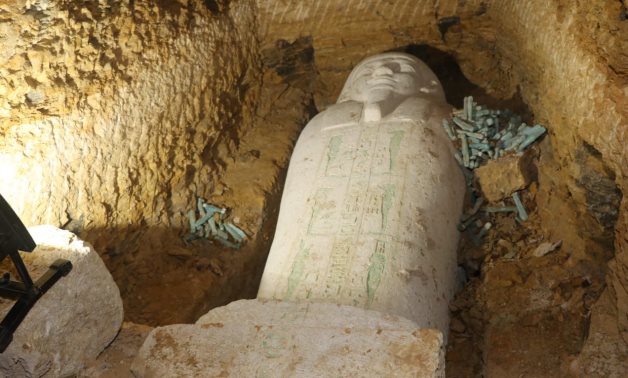Conny Waters – AncientPages.com – Two weeks ago, a team of Egyptian archaeologists discovered a burial well in Minya’s Al-Gharafa archaeological area of Tuna El-Gebel.

The limestone coffin, which was found in the well, features painted reliefs in good condition representing the four children of Horus. Image credit: Supreme Council of Antiquities |
A number of ushabti figurines, left with the deceased as servants for the afterlife, was found next to the coffin.
The sarcophagus that belongs to Djehuty Imhotep, a 26th Dynasty high priest of the god Djehuty, additionally contains a collection of amulets and scarab figurines of different shapes and sizes, said Mostafa Waziri, secretary-general of the Supreme Council of Antiquities and head of the excavation mission.
Amulets and figurines discovered in the recently unearthed sarcophagus in Minya, Egypt. Image credit: Supreme Council of Antiquities |
Waziri also informed that some of the amulets are heart-shaped and others depict the head of the goddess Hathor, the four sons of the god Horus, and a winged amulet.
He added that more excavations in the area revealed another 10-meter-deep burial shaft containing a large chamber with three niches covered by stone beams.
“The mission will remove these beams later this week to reveal what is hidden inside,” Waziri pointed out, as cited by Ahram Online.
Djehuty Imhotep also held the position of the supervisor of the thrones and was the son of Hersa Iset, whose sarcophagus was discovered in the area in 2018.
The excavations in Al-Ghoreifa began in 2018 and have since unearthed many communal tombs belonging to the high priests of the god Djehuty and senior officials of the 15th region of Upper Egypt.
The mission unearthed 19 tombs containing 70 stone sarcophagi of various sizes and shapes, as well as funerary collections.
Written by Conny Waters – AncientPages.com Staff WriterFacebookTwitterFlipboardPinterestEmailChia sẻ





